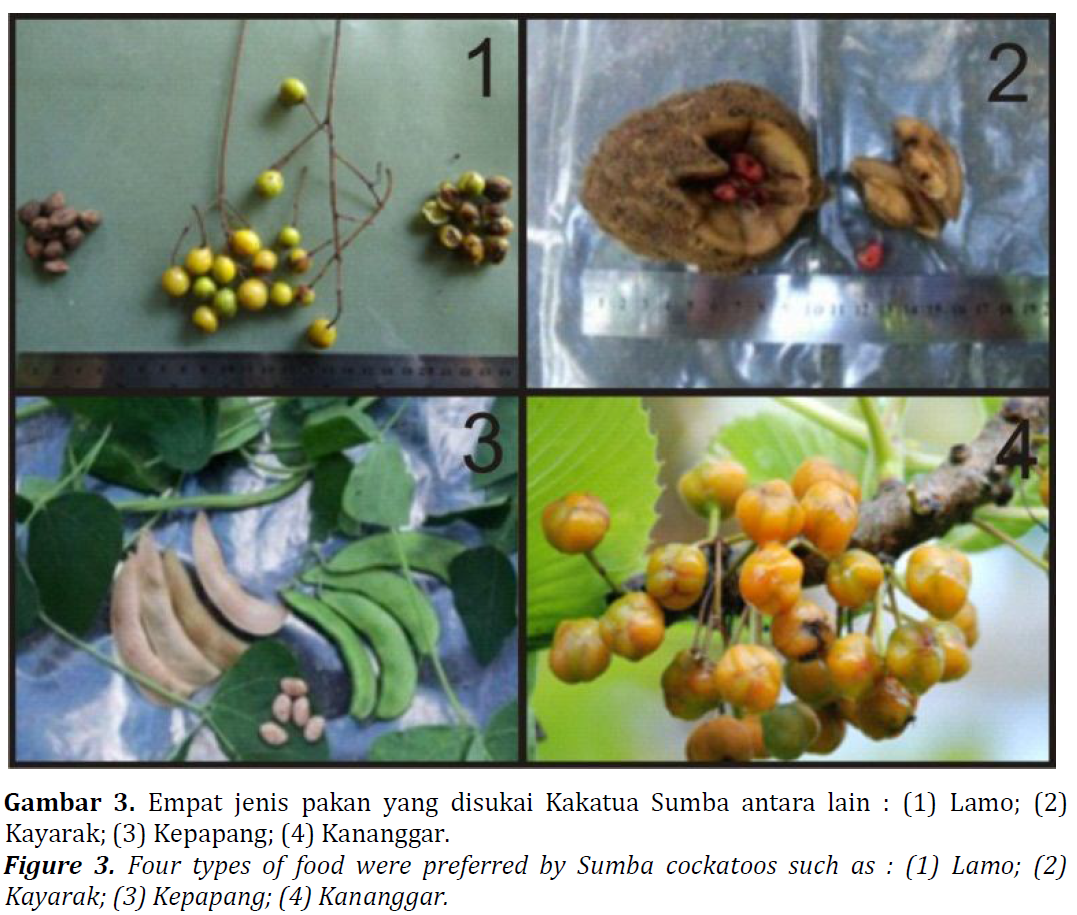Komposisi, preferensi dan sebaran jenis tumbuhan pakan kakatua sumba (Cacatua sulphurea citrinocristata) di Taman Nasional Laiwangi Wanggameti

Downloads
Sumba Cockatoo is an endemic bird and critically endangered in the island of Sumba. The population was declined drastically due to habitat degradation and illegal hunting. Management habitat activities such as enrichment important vegetation for Sumba Cockatoo has been made as in situ conservation ways. The purpose of this study was to determine the composition, preference and distribution of feeding plant species of Sumba Cockatoo at Laiwangi Wanggameti National Park. Vegetation analysis was made to know habitat characteristics by quadrat method with double compartment, with amount of 20 unit per location. The feeding preference was analyzed by Neu’s Method. The result showed that a total of 14 species were identified as food plants of the Sumba Cockatoo. The feeding plant spread uniformly at Praingkareha Forest Block and clumped at Billa and Mahaniwa. The most preferred food plant by Sumba Cockatoo were Lamo (Melia azedarach), Kayarak (Quercus piriformis) and Kepapang (Phaseolus lunatus) . All three have clumped distribution pattern.
Barbour, G.M., J.K. Busk, and W.D. Pitts. (1987). Terrestrial Plant Ecology. New York: The Benyamin/Cummings Publishing Company Inc.
Bashari, H. (2013). Nesting Ecology and Strategic Natural Treatment for The Nest of The Critically Endangered Yellow-Crested Cockatoo Cacatua sulphurea citrinocristata in Sumba. Proceeding International Conference Forest and Biodiversity, 479-484. Manado: Secretariat of Forestry Research and Development Agency-Sam Ratulangi University-Global Environment Facility-Burung Indonesia-Government of North Sulawesi Province-SEAMEO BIOTROP.
Bibby, C., M. Jones, dan S. J. Marsden. (2000). Teknikteknik ekspedisi lapangan survey burung. Bogor: Birdlife International-Indonesia Programme.
BirdLife International. (2014). Species factsheet: Cacatua sulphurea. http://www.birdlife.org. Diakses tanggal 3 Maret 2014.
Boyes, R.S., and M.R. Perrin. (2009). Flocking dynamics and roosting behaviour of Meyer's parrot (Poicephalus meyeri) in the Okavango Delta, Botswana. African Zoology, 44(2): 181 – 193.
Cahill, A.J., J.S. Walker., and S.J. Marsden. (2006). Recovery Within A Population of The Critically Endangered Citron-Crested Cockatoo Cacatua sulphurea citrinocristata in Indonesia After 10 Years of International Trade Control. Oryx, 40
(2), 1–7.
Cameron, M. (2007). Cockatoos. Australia: CSIRO Publishing.
CITES. (2013). Appendices 1, 2, 3. http://www.cites.org/eng/app/appendices.php. Diakses tanggal 4 Juli 2013.
Davis, A., C. E. Taylor, R. E. Major. (2012). Seasonal abudance and habitat use of Australian parrots in an urbanized landscape. Landscape and Urban Planning 106, 191–198. doi:10.1016/ j.landurbplan.2012.03.005.
Dias, R. (2011). Nesting biology of the Yellow-faced Parrot (Alipiopsitta xanthops), a species without nest-site fidelity: an indication of high cavity availability?. Emu, 111(3), 217-221. doi:10.1071/MU10076.
Forshaw, J. M. (2010). Parrots of The World. New Jersey: Pricenton University Press.
Hidayat, O., dan Kayat. (2013) Karakteristik dan Preferensi Habitat Kakatua Sumba (Cacatua sulphurea citrinocristata) di Taman Nasional Laiwangi Wanggameti. (KTI belum dipublikasikan).
Hidayat, O., dan Kayat. (2013). Distribution Mapping and Conservation Strategies of Citron-crested Cockatoo (Cacatua sulphurea citrinocristata) in The Fragmented Forest of Laiwangi Wanggameti National Park, East Sumba, East Nusa Tenggara. Proceeding International Conference Forest and Biodiversity, 479-484. Manado : Secretariat of Forestry Research and Development Agency-Sam Ratulangi University- Global Environment Facility-Burung Indonesia- Government of North Sulawesi Province- SEAMEO BIOTROP.
IUCN. (2013). The IUCN red list of threatened species. http:// www.iucnredlist.org. Diakses tanggal 4 Juli 2013.
Kartawinata, K.S., Soenarko, IGM. Tantra, dan T. Samingan. (1976). Pedoman inventarisasi flora dan ekosistem. Bogor: Direktorat Perlindungan dan Pengawetan Alam.
Kayat dan O. Hidayat. (2011). Kajian Pohon Sarang Kakatua Sumba (Cacatua sulphurea citrinocristata) di Taman Nasional Laiwangi Wanggameti. (Laporan Penelitian). Kupang: Balai Penelitian Kehutanan Kupang. (Tidak dipublikasikan).
Krebs C. J. (1989). Ecological methodology. New York: Harper dan Row Publisher.
Lee, J., H. Finn., and M. Calver. (2013). Feeding activity of threatened black cockatoos in mine-site rehabilitation in the jarrah forest of southwestern Australia. Australian Journal of Zoology, 61, 119–131.
Nandika, D., D. Agustina, S. Metz., dan B. Zimmermann. (2013). Kakatua Langka Abbotti dan Kepulauan Masalembu. Bekasi: Konservasi Kakatua Indonesia.
O’Brien, J. (2014). Husbandry guidelines for Cacatua spp. http: //www.aszk.org.au/ docs/ cacatua_husbandry_guidelines_o_brien.pdf. Diakses tanggal 13 Maret 2014.
Odum. E.P. (1993). Dasar-Dasar Ekologi. Edisi Ketiga. Yogyakarta: Gadjah Mada University Press.
PHPA/LIPI/Birdlife International-IP. (1998). Rencana Pemulihan Kakatua-kecil jambul-kuning. Bogor: PHPA/LIPI/Birdlife International-IP.
Rahmat, U.M., Y. Santosa., dan A.P. Kartono. (2008). Analisis Preferensi Habitat Badak Jawa di Taman Nasional Ujung Kulon. Jurnal Manajemen Hutan Tropika, 14 (3): 115–124.
Randler, C., M. Braun., and S. Lintker. (2011). Foot preferences in wild-living ring-necked parakeets (Psittacula krameri, Psittacidae). Laterality, 16 (2), 201-206.
Renner, S.C., S. Baur., A. Possler., J. Winkler., E.K.V. Kalkol. (2012). Food preferences of winter bird communities in different forest types. PLoS ONE 7(12), 1-10 : e53121.doi:10.1371/journal.pone. 0053121.
Rey, P.J. (2011). Preserving frugivorous birds in agroecosystems: lessons from Spanish olive orchards. Journal of Applied Ecology, 48, 228– 237. doi: 10.1111/j.1365-2664.2010.01902.x.
Stock, W.D., H. Finn., J. Parker., and K. Dods. (2013). Pine as Fast Food: Foraging Ecology of an Endangered Cockatoo in a Forestry Landscape. PLoS ONE 8(4), 1 - 12 : e61145. doi:10.1371/ journal.pone.0061145.
Warsito, H., and M. Bismark. (2010). Penyebaran dan populasi burung paruh bengkok pada beberapa tipe habitat di Papua. Jurnal Penelitian Hutan dan Konservasi Alam, 7 (1) : 93–102.
Williams, D.R., R.G. Pople., D.A. Showler., L.V. Dicks., M.F. Child., E.K.H.J. zu Ermgassen., and W.J. Sutherland. (2012). Bird Conservation: Global evidence for the effects of interventions. Exeter: Pelagic Publishing.
Wiyanto, T. (2011). Pembinaan habitan Kakatua jambul jingga. Waingapu: Taman Nasional Laiwangi wanggameti. Buletin Kakatua Edisi III.
Wotton, D. M., D. Kelly., and A. Traveset. (2012). Do larger frugivores move seeds further? Body size, seed dispersal distance, and a case study of a large, sedentary pigeon. Journal of Biogeography, 39(11), 1973-1983. doi:10.1111/jbi.12000.




